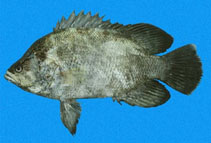Upload your photos and videos
Pictures | Google imageLobotes pacifica
Picture by Robertson, R.
Pictures | Google imageLobotes pacifica
Picture by Robertson, R.
Ecuador country information
Common names:
Berrugate, Zapata
Occurrence: native
Salinity: marine
Abundance: | Ref:
Importance: | Ref:
Aquaculture: | Ref:
Regulations: | Ref:
Uses: no uses
Comments: In range Ref. 9312.
National Checklist:
Country Information: https://www.cia.gov/library/publications/resources/the-world-factbook/geos/ec.html
National Fisheries Authority:
Occurrences: Occurrences Point map
Main Ref: Béarez, P., 1996
National Database:
Occurrence: native
Salinity: marine
Abundance: | Ref:
Importance: | Ref:
Aquaculture: | Ref:
Regulations: | Ref:
Uses: no uses
Comments: In range Ref. 9312.
National Checklist:
Country Information: https://www.cia.gov/library/publications/resources/the-world-factbook/geos/ec.html
National Fisheries Authority:
Occurrences: Occurrences Point map
Main Ref: Béarez, P., 1996
National Database:
Common names from other countries
Classification / Names Nombres comunes | Sinónimos | Catalog of Fishes(Género, Especie) | ITIS | CoL | WoRMS | Cloffa
> Acanthuriformes (Surgeonfishes) > Lobotidae (Tripletails)
Etymology: Lobotes: Latin, lobus = lobe (Ref. 45335).
More on author: Gilbert.
Etymology: Lobotes: Latin, lobus = lobe (Ref. 45335).
More on author: Gilbert.
Environment: milieu / climate zone / depth range / distribution range Ecología
marino; salobre bentopelágico. Tropical
Distribución Países | Áreas FAO | Ecosistemas | Ocurrencias, apariciones | Point map | Introducciones | Faunafri
Tamaño / Peso / Age
Maturity: Lm ? range ? - ? cm
Max length : 100.0 cm TL macho / no sexado; (Ref. 9312); common length : 50.0 cm TL macho / no sexado; (Ref. 9312)
Max length : 100.0 cm TL macho / no sexado; (Ref. 9312); common length : 50.0 cm TL macho / no sexado; (Ref. 9312)
Short description Claves de identificación | Morfología | Morfometría
Body deep and moderately compressed, the depth much greater than head length; eyes small; upper jaw scarcely protractile; vomer, palate and tongue toothless; nostrils round and close together; preopercle distinctly serrated; lower branch of first gill arch with 15 gill rakers; in large individuals, the dorsal and anal fins, along with the caudal fin, appear like 3 caudal fins; body olive colored, speckled with dark spots; juveniles yellowish with dark spots (Ref. 55763).
Feeds mainly on benthic crustaceans and small fishes (Ref. 9312).
Life cycle and mating behavior Madurez | Reproducción | Puesta | Huevos | Fecundidad | Larva
Main reference
Upload your references | Referencias | Coordinador | Colaboradores
Heemstra, P.C., 1995. Lobotidae. Dormilonas. p. 1226. In W. Fischer, F. Krupp, W. Schneider, C. Sommer, K.E. Carpenter and V. Niem (eds.) Guia FAO para Identification de Especies para lo Fines de la Pesca. Pacifico Centro-Oriental. 3 Vols. FAO, Rome. (Ref. 9312)
Threat to humans
Harmless
Human uses
Pesquerías: comercial; pesca deportiva: si
FAO(Publication : search) | FishSource | Sea Around Us
Más información
Trophic ecology
componentes alimenticios
Composición de la dieta
consumo de alimento
Food rations
Despredadores
componentes alimenticios
Composición de la dieta
consumo de alimento
Food rations
Despredadores
Ecology
Ecología
Home ranges
Ecología
Home ranges
Population dynamics
Coeficiente del crecimiento para
Max. ages / sizes
Length-weight rel.
Length-length rel.
Length-frequencies
Mass conversion
Reclutamiento
Abundancia
Coeficiente del crecimiento para
Max. ages / sizes
Length-weight rel.
Length-length rel.
Length-frequencies
Mass conversion
Reclutamiento
Abundancia
Life cycle
Reproducción
Madurez
Fecundidad
Puesta
Spawning aggregations
Huevos
Egg development
Larva
Dinámica larvaria
Reproducción
Madurez
Fecundidad
Puesta
Spawning aggregations
Huevos
Egg development
Larva
Dinámica larvaria
Anatomy
Superficie branquial
Brain
Otolith
Superficie branquial
Brain
Otolith
Physiology
Body composition
Nutrients
Consumo del oxígeno
Tipo de natación
Velocidad de natación
Visual pigments
Fish sound
Diseases & Parasites
Toxicity (LC50s)
Body composition
Nutrients
Consumo del oxígeno
Tipo de natación
Velocidad de natación
Visual pigments
Fish sound
Diseases & Parasites
Toxicity (LC50s)
Genetics
Genética
Heterozygosity
heritabilidad
Genética
Heterozygosity
heritabilidad
Human related
Aquaculture systems
Perfiles de acuicultura
Razas
Ciguatera cases
Stamps, coins, misc.
Aquaculture systems
Perfiles de acuicultura
Razas
Ciguatera cases
Stamps, coins, misc.
Herramientas
E-book | Guía de campo | Asistente para frecuencias de tallas | Herramienta de ciclo de vida | Mapa de puntos | Classification Tree
| Catch-MSY |
Special reports
Download XML
Fuentes de Internet
Aquatic Commons | BHL | Cloffa | Websites from users | Check FishWatcher | CISTI | Catalog of Fishes(Género, Especie) | DiscoverLife | ECOTOX | Faunafri | Fishtrace | GenBank(genome, nucleotide) | GloBI | GOBASE | | Google Books | Google Scholar | Google | IGFA World Record | MitoFish | OsteoBase(skull, spine) | Otolith Atlas of Taiwan Fishes | PubMed | Reef Life Survey | Scirus | SeaLifeBase | Árbol de la vida | Wikipedia(Go, búsqueda) | World Records Freshwater Fishing | Expediente Zoológico
Estimates based on models
Phylogenetic diversity index (Ref. 82804): PD50 = 1.0000 [Uniqueness, from 0.5 = low to 2.0 = high].
Bayesian length-weight: a=0.01862 (0.00834 - 0.04158), b=3.01 (2.81 - 3.21), in cm Total Length, based on LWR estimates for this (Sub)family-body shape (Ref. 93245).
Nivel trófico (Ref. 69278): 4.1 ±0.6 se; based on size and trophs of closest relatives
Resiliencia (Ref. 120179): Medio, población duplicada en un tiempo mínimo de 1.4-4.4 años (Preliminary K or Fecundity.).
Fishing Vulnerability (Ref. 59153): High vulnerability (60 of 100).




